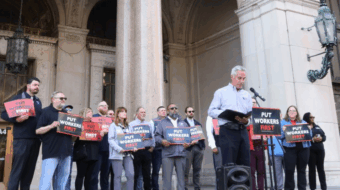Bush administration is root cause, expert charges
PITTSBURGH — “The collapse of MSHA began when Bush appointed David Lauriski in 2001,” says mine safety expert Jack Spadaro. “That set in motion all the processes and disasters in coal mining making headlines now.”
MSHA is the federal government’s Mine Safety and Health Administration. Lauriski was a former mine company executive.
Just before Thanksgiving, the inspector general for the Labor Department released a 65-page report adding more pieces to the puzzle of why more coal miners are dying at work, despite the revolution in mining technology and tightened safety laws.
In 2006, the year of the worst coal mining disaster in decades at the Sago Mine, inspectors failed to examine 1 in 7 of the country’s 731 mines, according to the report. Crandall Canyon Mine, site of an August cave-in that took the lives of six miners and three rescuers, was on the list of 102 mines that were either not inspected or not inspected properly under the law. The number of coal miners who died at work doubled in 2006 to 47.
The report said that lack of funding and mismanagement by the Bush administration are responsible for declining safety standards in coal mining, reversing 30 years of progress ushered in by the Mine Safety and Health Act of 1977.
“People inside MSHA are upset and many are leaving,” said Spadaro in a telephone interview. “They are dedicated, trying to do a good job because they know the decisions they make are life and death. It is the top of the agency that is incompetent.”
Spadaro has 38 years of mining engineering experience, including seven as the superintendent of the National Mine Health and Safety Academy, which trains mining inspectors. In 1993, Spadaro was awarded “Engineer of the Year” by the National Society of Professional Engineers.
While coal production and profits for coal companies rose 9 percent between 2002 and 2006, the number of MSHA safety inspectors plummeted by 18 percent, from 605 to 496, for all 731 mines.
The report drew fire, though, for whitewashing the procedure to determine if a death in the mines is a “chargeable death.” For instance, if someone comes onto mine property and falls into a shaft, that may not be a chargeable death.
After reviewing 152 chargeable death decisions between 2004 and 2006, the report did not find any problems. But an independent investigation by the Pittsburgh Post Gazette found that nonchargeable deaths had increased, and the criteria for “reportable deaths” had narrowed significantly.
MSHA tinkered with the fatality numbers to generate press releases heralding an increase in mine safety. Then Sago blew up in January 2006.
“Coal mines are no safer now than before Sago,” Phil Smith, spokesman for the United Mine Workers of America (UMWA) union, charged. “Large chunks of the Miner Act [recent upgrading of the 1977 Act in the wake of Sago] are not yet in place. Right now we are in a ‘study’ period, and it will be at least three years from June 2007 before any positive changes are in place for communications and other reforms are implemented. That was added on to the law at the very end. Delays can cost lives.”
It was a related development in coal mining that put the zing in Smith’s voice over the phone. On Nov. 21, administrative law Judge Paul Bogas decided in favor of the union and against Massey Energy, the fourth-largest coal corporation in the United States.
“It was a body slam,” said Smith on Bogas’ decision to reinstate 85 miners back to their jobs after Massey fired them for union sympathies. The miners worked at Massey’s Mammoth Mine, formerly called Cannelton. He also ordered Massey to sit down and bargain a contract with the UMWA at this mine. “It is difficult — with the Bush NLRB — but this is a foot in the door with Massey,” he said.
Massey is a notorious union buster in the coal fields, a major political player in West Virginia politics and a leader in the controversial mountaintop mining technique, where coal companies blow off the entire tops of mountains for coal underneath.
dwinebr696 @aol.com










